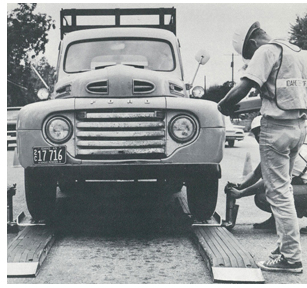

From The ITD Vault: 50 Years Ago
Weight Study Program Helps Highway Planning
Idaho’s economic lifelines hinge upon the continued development of today's highway needs and further expansion for traffic requirements of the future. One phase of the continuing program to gather vital information concerning vehicle classification, traffic volume data, and the measure of the use of Idaho's highway system, is the Department's Truck Weighing operation.
This operation, conducted by Planning and Traffic Division personnel, is utilized to determine axle and vehicle weights, axle spacing, and loading practices. This knowledge is useful in the design of pavements, location of heavy duty truck routes, development of size and weight trends, allocation of highway costs and revenue, and a variety of special administrative, planning, design and research studies.![]()
Twelve weighing stations are operated routinely each summer by the Idaho Department of Highways. These stations are strategically located throughout the state to produce representative samples of truck weights and classes. Weighing facilities include Port of Entry platform scales, pit scales located adjacent to the roadway, and portable scales which are used at the centerline of traffic lanes.
Excellent cooperation related to traffic control and safety is received from the State Police of the Department of Law Enforcement. It is worth noting that the 4,880 miles of the State Highway system in the state carry approximately 67 percent of all the travel. Approximately fifteen percent of the travel on the State Highway System consists of heavy truck traffic.
Construction of facilities to properly serve this heavy truck traffic is considerably more expensive than building roads to serve passenger car arid light truck traffic normally found on local road and street systems. Idaho traffic studies indicate that most local roads and streets generally do not carry heavy truck traffic. On many such facilities, less than five percent of the total traffic consists of heavy trucks.
To illustrate the effect of varying vehicle classes on the State Highway System, data derived from the nationally financed AASHO (American Association of State Highway Officials) Road Test, indicate the impact of a single 18,000-pound axle is equivalent to 5,000 axle loads of 2,000 pounds or less. Applying this information to truck weight data collected in Idaho, the road test findings show on the average, one five-axle semitrailer is equal to 2,700 passenger cars in the pavement life of a structurally adequate road street.
This program and many others supported by the Planning and Traffic Division indicate the complexity of present day highway development. The Department of Highways, individuals, civic groups, city officials, and county and state representatives must all work together to meet the challenge of the future. Public interest, understanding, and support are necessary to carry out the tasks involved in all phases of highway improvements.
Editor’s 2016 Note: The passage of time seems to take the air out of most things, but this topic has only grown more hotly contested in the span of a half century. ITD now has an extensive program to address heavy trucks, spearheaded by Registrations, the Ports of Entry system, with locations throughout the state, and Permits. Add to that the Roving POEs that patrol the state’s secondary and bypass routes, using portable weigh scales.
Published 05-06-16